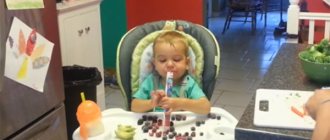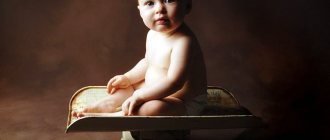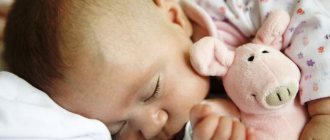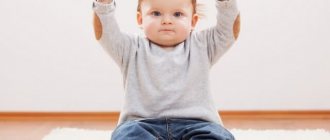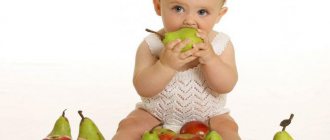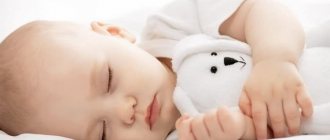Norms
Your child is now 1.1 years old. And by this age, many changes have occurred. Most children at this age already have 8 teeth. A child's height at 13 months ranges from 73 to 78 cm for boys, and weight ranges from 9 to 11 kg. Girls are slightly smaller than boys, with an average height of 71 to 77 cm and a weight of 8 to 10 kg. The head circumference of children at 13 months varies from 43 to 48 cm.
Deviation from the above norms to a lesser or greater extent is a reason to consult a doctor, especially if this has not been observed before.
Physical development
Let's look at how a child develops and what he can do at 13 months. After a year, babies do not change so actively in terms of height and weight, as this process slows down a little. That is why it is no longer so important to weigh the baby and measure its growth every month. An exception may be situations when the baby exhibits serious deviations from standard indicators.
At 1 year and 1 month, the child becomes very independent. Most children can walk, and those who have not yet learned to actively crawl on all fours and also walk with their parents by the hand.
By the age of one year, parents should take care of safety in the home. Since from 13 months it is common for a baby to learn everything new, dangerous objects in the house should be inaccessible to the child.
FAQ
How many words should a 13 month old child say?
There is no clear answer to this question, since speech development in children occurs at an individual pace.
At 13 months, some children can say “mama,” “bye-bye,” or other simple words. If you are concerned that your child is not speaking at 13 months, discuss this with your pediatrician. Should a child walk at 13 months?
Some children walk at 13 months, and some do not.
The time interval that is considered normal for starting walking is very wide. And if your baby hasn't gone yet, he probably will soon. According to experts, children begin to walk at the age of 12–18 months. If you are concerned that your baby has not yet walked, or have other questions about his development, consult your pediatrician. How much sleep does a 13 month old baby need?
A 13 month old child needs 12–14 hours of sleep per day.
What should a 13 month old child be able to do?
All children develop at their own pace. Here's what your baby can learn to do at this age or a little later:
- Say a few simple words (for example, “mom” and “dad”).
- Understand simple words from everyday life (for example, “cup”).
- Recognize familiar faces.
- React to sounds by turning around and trying to understand where they are coming from.
- Follow simple instructions (for example, if you ask him to show his favorite teddy bear).
- Enthusiastically knock an object against an object, enjoying the sound.
- Do some actions to observe your reaction (for example, throwing a cup so that you pick it up).
- Pick up large objects by holding them between your thumb and forefinger.
What to do if a child has a fever at 13 months?
To measure temperature, take a special children's thermometer. Typically, temperatures above 38° are considered fever. If a child has a temperature of 39.5° or higher, you should immediately consult a doctor. Learn more about fever in young children so you know what to do, and ask your pediatrician any questions you may have.
What kids can already do
New baby skills include walking backwards and consciously playing with a ball. Moreover, the baby can kick not only a large ball, but is already able to play with a small one. Children especially love everything unknown, so closed cabinets become the most interesting part of the house. Pulling out clothes and throwing them around is perhaps an activity that is very exciting for children at this age.
A 13 month old baby is very proud of his walking skills. Children of this age category still walk quite funny, but they are quite confident on their feet.
A 13-month-old child does not walk independently
If after a year the baby still does not attempt to walk independently, then this could be due to the following reasons:
- Heredity.
- The presence of unsuccessful attempts in mastering the first steps.
- Excess body weight of the baby.
- The little one is lazy.
You should not blame yourself or your baby for such a problem. Try to encourage your baby to take the first steps. Use your child’s favorite toys and praise for such purposes. Children of this age especially love balls, and you just need to offer to catch up with the baby as he rolls on the floor.
What should a 13 month old child be able to do?
- The baby knows how to sit at the table independently and makes his first attempts to eat on his own.
- The baby fulfills simple requests, such as: “bring a toy”, “show where the ball is”, and also knows the names of some toys and objects in the house.
- In addition to humming, the baby already knows how to pronounce some syllables. This especially applies to imitation of animal voices (meow, woof, moo-moo and others).
- A child at this age has realized that he can influence objects and is practicing this skill with all his might. Namely: pushing cars, throwing a ball, hiding toys, etc.
- There is little communication with parents for the baby. And he actively begins to reach out to the kids on the playground. And the children of friends and relatives give the baby a wealth of experience related to how to make friends and behave in conflict.
Neuropsychic development
The development of a child at 13 months is determined by the acquisition of new qualities. The baby wants to be the center of attention. And when the parents are busy with something, the baby willingly tries to help. Most often this concerns cleaning or cooking.
You shouldn’t stop your child’s initiative, even if he bothers you. The child wants to be useful to adults, and prohibitions and irritability on the part of the parents will only discourage him from all desire for such activities in the future.
Young parents: always on the alert
A 13 month old baby is very active and inquisitive. But at the same time, he is not yet able to understand your instructions about what he can do and what he can’t do. This means that at this age, one of your main tasks as a parent is to remain vigilant and make sure that your baby is safe. For example, if your 13-month-old child picks up a fragile object, he will not be able to comply with your request to carefully put it back in its place. Instead, you will need to take the item from him, put it out of the child's reach, and in return give him something safe to play with. Over the coming years, you will learn the important skill of responding quickly and distracting your child's attention with an alternative, safe object or toy to play with. A safe home for the baby promotes the development of independence and mobility without unnecessary worries for parents. Here are safety measures you can take in your living room: install plugs on sockets, padded guards on the corners of the coffee table, and gates on doorways and staircases. Keeping your eyes on your little fidget and anticipating every next move can be exhausting. Reinforce yourself with the idea that introducing your child to the world in a safe environment is very important for his healthy and happy development.
Baby's vocabulary at 13 months
Some children already begin to master spoken language after a year. Of course, the vocabulary is still very small. The norm for 13 months is 10 words. In practice, children speak less. There is nothing wrong with this, but it is very important to communicate with your baby. Be sure to read fairy tales to him, recite rhymes and talk to him as often as possible.
To determine how well your child is learning the information he hears, take the following test. Ask your child to bring something from the toys, identifying the object by its name. When a child is 1 year 1 month old, he already knows the names. And accordingly, he should easily fulfill your request.
Don't worry too much if your baby hasn't started talking after a year. It is quite possible that this is due to individual developmental characteristics. Of course, it may be that adults spend too little time on this issue, namely, they rarely or talk too quickly with the child.
To stimulate the development of this skill, parents need to talk with their child often, try to regularly comment on what is happening and read fairy tales before bed.
Water procedures and hygiene
Nothing has changed in these procedures compared to last month.
- Allow your baby to continue to move independently and play with toys while bathing.
- There is no need to limit the time your baby spends in the bathroom. There are children who really like to swim. At this moment, they receive a sea of positive emotions, which has a beneficial effect on their body. If your baby hates water treatments, then there is no need to force him to stay in the bathroom longer than expected.
- A mother should not forget about the hygiene of her child. Therefore, daily procedures related to cleaning the mouth and washing are important.
- If your baby still doesn’t sit on the potty, it’s also time to train him to do this.
- Do not forget that the baby must be washed after each bowel movement. 6. It is very important to clean your baby’s nose and ears, but you should not do this more than 2 times a week.
- Bathing is not a daily procedure, only if the child wishes. Therefore, water procedures can be performed three times a week.
Nutrition
When a child is 1 year 1 month old, many parents mistakenly believe that it is too early to transfer him to the common table. The main mistake in the diet is ground porridge, vegetable and fruit purees. It is very important to prepare food for your baby, leaving some of it not completely ground (small pieces). The child must master chewing skills and also learn to distinguish the tastes of foods.
After a year, you can stop breastfeeding and replace breast milk with regular foods. It is very important not to forget to give your baby something to drink regularly. These can be juices, compotes and water.
A child's diet at 13 months allows fish and meat to be included in the diet. These products have a beneficial effect on mental and physical development. After one year, the baby should already have his own personal dishes, cutlery and high chair.
Protect your child from sweets, as at this age it is undesirable for him to try them. Fruits are much healthier and tastier.
It is very important to prepare meals for your baby from fresh ingredients. It is advisable that these are trusted stores and manufacturers. Never cook food with artificial additives.
Child development 1 year 1 month
At the beginning of the 2nd year, the baby is often faced with the novelty of the world around him, finding himself in difficult, sometimes traumatic, situations: when he sees a gap, he will definitely stick his finger into it (this can be not only a door, a cabinet, but also a tin can, a bottle), in the form of a shiny iron, he reaches for it, not knowing that he can get burned, or he pulls a tablecloth with dishes onto the floor, ending up on his head. The baby’s cognitive activity is so great that even the painful sensations received during the first “lessons” do not cause fear, but become lessons of courage and perseverance.
A child’s curiosity is based on an innate orientation reflex (reaction to novelty), which is given to people by nature itself.
Adults should take into account this peculiarity of the baby: on the one hand, the world attracts the child with its uncertainty, on the other, it teaches caution. Yes, such is this period of childhood. Of course, the baby’s behavior is based on reflex reinforcement: a child cannot be different, the nature of his age speaks in him.
Parents should know that at the beginning of the baby’s second year, they should not be deprived of the joy of exploring space and accumulating sensory (feeling) experience, no matter how difficult it may be to manage the fidget.
Communication with adults and their “business” contacts in games with objects and toys are a necessary condition for the mental and physical development of the baby. It has been noticed that the child becomes especially attached to and singles out the adult who most often enters into “business” and play contacts with him.
Of course, the child’s socialization continues, that is, his entry into the society of people, the assimilation of the forms of their behavior and relationships, the formation of a human vision of the world. Strengthening of this line of development will occur throughout the entire 2nd year of life, but in the meantime there is a transition in relationships with adults from actions “next to” to actions “together”. The child masters an active life “business” position with a focus on independence and “discovering oneself as a doer.” That is why it is impossible to hold the baby in place; the child needs to touch, feel, and see everything the adult reacts to his actions. Getting to know the environment, entering the world, the baby gradually begins to understand himself, his own “I”, to feel his place in the social environment of his family and friends.
First of all, the child masters a variety of external actions: takes the first independent steps, including towards an object, takes out a toy from a standing position, carries it, strings rings onto a rod, and not only removes and throws it away, tries to hold a spoon independently.
It doesn't break, it learns!
The first three months of the second year of life are different in that the baby experiences an increase in motor skills. He imitates an adult, mastering more and more new actions with objects.
Objective activity remains leading during this period of childhood. A huge role is played by the child’s object games with didactic toys: rings, pyramids, balls, cubes, insert items.
They shape his thinking, which in the early period of childhood is visual and effective in nature. Mental operations of analysis and synthesis, comparison and first generalizations take place in detailed, practical action with toys: for example, connecting and separating rings, balls, insert cubes, colored caps.
“You can’t give anything to a child; he breaks everything, takes it apart, tears up books and pictures!” - parents complain, suspecting their pet of mischief. In fact, this behavior indicates that the baby “analyzes” and “synthesizes” in action with objects unfamiliar to him, learning their physical properties.
That is why toys consisting of different parts are useful for the baby. When laying them out, the baby does not break the object, but takes it apart. Then it reassembles. This feature of children at the beginning of the 2nd year of life was brilliantly “guessed” in folk toys: nesting dolls, barrels, painted eggs, pyramids.
I would like to note that the child’s first games with collapsible objects “prepare” higher forms of mental activity in the depths of visual-effective thinking. The child gradually learns to establish “internal” connections between objects, combining or separating them according to some characteristics. But this is in the future, but for now the baby is discovering sensorimotor intelligence. He reacts only to what is in front of his eyes and what he directly sees in the hands of an adult or in his own palms.
It is noticeable that the child shows greater interest in objects that are in the hands of adults, and which mom and dad give a positive assessment in his presence. Even the most inconspicuous car in this case becomes a priority for the baby compared to any of the brightest and most spectacular. The baby's impulsiveness, the quick transition from tears to laughter and vice versa - in terms of these qualities in the baby's behavior, he is very close to the baby at the end of the first year. He is very dependent on the situation, he lacks planning and forecasting of his own actions, and lacks volitional behavior. Sometimes it doesn’t even occur to an adult that the baby might have a miscarriage in the next minute. That is why parents need to know the peculiarities of age and learn methods of communicating with the baby, supported by an emotional, indicative and sensory basis - show a toy, play “Okay”, “Let’s go, let’s go”, “Hide and Seek”. Small folklore genres for the little ones, such as nursery rhymes, songs, and poems, will also help. But they should be sung and read from memory, very emotionally, changing facial expression, voice intonation and its strength.
Sound toys are also loved by babies at the beginning of the 2nd year: drums, tambourines, bells, rattles. The child quickly learns their timbre. And by the age of 1 year 3 months, he not only “plays” on his own, but also finds them at the request of adults.
The emotionality of a child is also manifested in the fact that children at this age do not control their feelings. Therefore, great patience and wisdom are required from adults, especially from mother and father. The second year is the most difficult in the life of parents, because the child demands “eye and eye” for him. Many objects have hidden properties that the child does not yet have the slightest idea about. Indeed, how can you know what is hot - cold, sharp - dull, smooth - prickly, if you don’t touch it?
We control the development process
At each stage of early childhood, a baby must reach certain heights. Its development continues at a rapid pace even after a year, if adults pay due attention and care to the baby. It should be borne in mind that the transition from infancy to early childhood does not occur overnight, but occurs gradually, throughout the entire 2nd year, as the baby grows and develops. But this is not a spontaneous process that takes place without the participation of an adult. And here one should not rely on the strong nature of childhood, on the fact that the child will automatically reach the heights of human development. If there are no favorable social living conditions, developmental communication and a nurturing environment, as well as the active activity of the baby himself, the child’s mental development may remain at the level of infancy. That is why teachers, psychologists, and doctors “monitor” how the baby develops through microperiods of his life. This system of testing mastery of relevant mental actions, skills and abilities is tested not only in the 1st year, but also in the 2nd year of the baby’s life, and four trimesters: from 1 year to 1 year and 3 months, from 1 year 3 months to 1 years 6 months, from 1 year 6 months to 1 year 9 months and from 1 year 9 months to 2 years - these are “milestones” in progressive development. Each trimester has its own tasks and is designed for the appropriate level of assimilation and development. If a child is 2-3 trimesters behind the norm, this is characterized as severe mental retardation. It is necessary to look for the reasons for this condition of the baby and correct its development.
The leading lines continue to be cognitive, social, speech and motor development. There does not seem to be much progress in the development of speech: the child uses exclamations, imitative speech reactions and babbling words. The baby understands much more words than he can pronounce. Sensory education and the development of actions with objects still play a large role in mental development. From 1 year to 1 year 3 months, the development of movements and improvement of the child’s walking acquires special importance. Restriction of physical activity can result in nervous breakdowns for the baby. He begins to demonstrate his “disobedience,” irritation, nervousness, and sometimes lethargy, indifference to everything. It is very important to start the 2nd year in a timely and correct manner, implementing the tasks set in the first trimester.
Educational tasks:
Continue to improve the development of basic, general movements and purposeful actions of the hand. Expand the child’s motor capabilities. Actively develop coordination of movements when walking, changing body position and direction of movement. Develop a sense of balance when performing actions with objects (toys), moving from a “sitting” position to a “standing” position and vice versa. Develop a child’s orientation in near space. On an indicative-sensory basis, promote the knowledge of objective physical laws of the surrounding world: different distances (far - close), the peculiarity of hollow and through space, the ratio of quantities (small - large, you can put a small nesting doll in a large one and a small glass in a large one, and not vice versa) and the dependence of actions on the form (stack cubes, roll balls). Continue to develop intelligence and speech: introduce the names of objects, develop elementary generalizations, cognitive and communicative functions of speech. Promote the stability of the child’s emotionally positive states. Protect the baby’s nervous system from stress and excessive emotional tension. Build trust in the world around you and a friendly attitude towards people around you. To develop the first skills and habits - to enjoy neatness and neatness in physical condition and clothing. Develop feasible independence in some processes (eating, washing, dressing). Provide your child with a healthy lifestyle.
Mini-program for the first trimester of the second year of life:
Encourage the child to walk independently. Create situations that encourage changes in the body in space - turns, bends, squats. Help your child master the ability to carry light objects (toys) at a distance of 3-5 meters, and step over low obstacles (10-12 cm). Climb with them to the height of the children's slide (at an extra step). Expand the child’s sensory experience when acting with objects using didactic toys and aids: rolling balls, folding cubes, stringing rings on a rod; practical actions with insert toys (putting colored caps and cubes in and out of each other); classes with folk collapsible toys (assembling and disassembling nesting dolls, pyramids, bochata). Expand the stock of understandable words (50-100), activate babbling speech by introducing individual lightweight words (“ga-ga” - duck, “lyalya” - doll, “top-top” - go). Expand your active vocabulary (10-15 words). Gradually expand the baby’s social contacts with outside adults and children. In a children's community, form the game “nearby” (that is, do not interfere with a friend playing nearby). Continue to perform game “learned” actions (“Okay”, “Goodbye”, “Hide and Seek”, etc.). Notice and react correctly to wet pants, a drenched bib, and dirty palms. Teach how to confidently hold a cup in your hands, use a spoon, hand a handkerchief, or a hat when dressing. Eliminate physical inactivity (inactivity), provide the child with the correct regimen, conduct hardening, and gymnastics.
Dream
A child's routine at 13 months is based on the correct daily routine. Children of this age category tend to divide their night sleep into 2 parts. During the day, babies also sleep 2 times, at least one hour each. Rest at night takes from 10 to 13 hours.
At the age of 1 year 1 month, children can be divided into several types, depending on the frequency and duration of sleep:
- Larks usually go to bed around 8–10 pm and wake up at 4–5 am. Then they begin to become active or ask for the breast.
- Owls go to bed by 11 pm and wake up around 7 am.
- Pigeons do not have a clear rest schedule. And it is most difficult for parents of such children to bring the regime back to normal.
1 year 1 month child's daily routine
Once your child is one year old, routines continue to play an important role. The baby becomes more active, sleeps less, learns new games and skills. What should be the daily routine of a 1 year 1 month child, how best to organize it, how much time to devote to sleep, walks and games.
- How to create a daily routine
- How to adjust the daily routine of children who wake up late
- What is the difference between the daily routine of children who are early risers?
- How much sleep should a 1 year 1 month child sleep?
- Sample feeding schedule
- Komarovsky about the daily routine
- What to do with homeless children
How to create a daily routine
After reaching 1 year 1 month, it is easier to clearly formulate a daily routine if the baby is accustomed to a certain schedule from the first months of life.
At this age, he sleeps 1-2 times during the day, eats 4 times, walks 1-2 times, and plays educational games. And the day ends with water procedures.
When creating a regime for your baby, it is important to take into account his character and individual characteristics. For example, some people still need to sleep twice a day, while some children can already get by with one nap during the day.
There are children who happily fall asleep on their own when they have already played enough and are tired. Others do not sleep, but become irritable and whiny due to overwork.
A clear daily routine helps to avoid bad mood and problems with appetite.
Having become accustomed to a certain alternation of activities that occurs at the same time every day, the child himself will wait for the next nap, walk or meal.
Children who need rest twice a day fall asleep at 11 o'clock (if they woke up at 8 am). Sleep lasts from one and a half to two hours.
Useful tips for mothers: CHILD UNDER 3 YEARS OLD
The second time, it is better to put the baby to bed at 16:00. He will sleep for an hour to an hour and a half, and then go to rest for the night at 21:00.
If your baby naps once a day, he usually needs to rest by 1 pm. Night sleep also begins at 21:00.
How to adjust the daily routine of children who wake up late
In addition to the regime, it is worth considering the child’s biorhythms. After 12 months they are already well formed. If your baby prefers to go to bed late and get up at 9-10 am, he can be called a “night owl.”
It is unlikely that it will be possible to completely change the regime. The child may become nervous and whiny. But you can adjust getting up and falling asleep for a few hours.
So, you can wake him up at 7-8 in the morning. Over time, he will get used to waking up at this time on his own. This means he will go to bed earlier.
To help your baby fall asleep better, it is recommended to stop active games 2 hours before bedtime. At this time, you can do drawing, modeling from plasticine, and reading.
It is also useful to take relaxing baths with herbs or essential oils and light massage.
What is the difference between the daily routine of children who are early risers?
If your child gets up early, don't try to change it. This routine will come in handy when it’s time to go to kindergarten and school.
As a rule, “larks” fall asleep at 20 o’clock, and at 6-7 am they already wake up their parents. Sometimes mothers try to change this routine by putting their baby to bed later.
But even in this case, he most often wakes up at his own time, and during the day he turns out to be moody and lethargic.
How much sleep should a 1 year 1 month child sleep?
In total, the baby sleeps 12-13 hours a day. Night sleep takes 10-11 hours, daytime sleep takes 2-3 hours.
If he sleeps enough, he feels alert and cheerful.
If he often wakes up at night and does not sleep well during the day, it is important for parents to find out the reason in order to eliminate it.
Some of the most common causes of sleep problems include:
- teething;
- heat, stuffiness;
- cold;
- lack of vitamin D;
- wet bed.
If you cannot solve the problem yourself, it is better to contact your pediatrician. With regular lack of sleep, the baby will be capricious, lethargic, and there may be interruptions in appetite.
Sample feeding schedule
Even if the baby continues to eat mother’s milk or formula, his diet must necessarily contain cereals, soups, fish, meat, fruits, and vegetables.
On average, by this age children have already grown 8 teeth. They are able to eat not only crushed food, but also small pieces no larger than 3 cm in size.
The interval between feedings is about 4 hours. This is enough for the food to be digested and a feeling of hunger to appear.
It is better to avoid snacking between main meals. Especially in the form of sweets or baked goods. If necessary, you can use fruits and vegetables for small snacks.
Feeding time table:
| Time | Dishes |
| Breakfast 8.30-9.00 | You can make milk porridge from any cereal. Add butter, fruits, dried fruits, berries to it. For porridge you can offer cottage cheese, kefir, fermented baked milk or yogurt. |
| Lunch 12.30-13.00 | Soup or puree is suitable for lunch. At this age, children enjoy eating meat or fish soufflé, cutlets, and meatballs. For dessert they offer fruits or berries. |
| Afternoon tea 15.30-16.00 | At this meal, the baby will happily drink kefir, yogurt or fermented baked milk, eat cookies, buns, fruits, and cottage cheese. |
| Dinner 19.00-20.00 | Before going to bed, you can cook the porridge again. And for dessert, fruit and jelly or another drink. |
If the mother continues to breastfeed or gives the baby formula, they are given before bed as an additional late dinner.
Following a clear diet by the hour helps the timely production of gastric juice, the appearance of appetite, the baby’s interest in food, and the habit of eating at the same time and at the same table with adults.
Gymnastics
It is useful to do morning exercises with children at this age. This way the baby wakes up sooner, becomes cheerful and active. To interest him, it is better to conduct classes in the form of a game.
You can accompany the exercises with nursery rhymes or songs.
For a child to want to study, he needs to set an example. The gymnastics room should be ventilated and the child should be lightly dressed.
Exercises will help strengthen walking skills or learn to walk faster if the baby has not yet taken his first independent steps.
Washing
This is another important procedure in the life of a one-year-old child. It is necessary to wash it in the mornings and evenings.
It is also important to accustom him to other hygiene procedures - washing hands before and after feeding, brushing his teeth.
At first, dentists recommend brushing your teeth once a day.
Use warm water to wash. The baby must be comfortable, otherwise he may develop a fear of water procedures.
Having gotten used to this routine, he will be happy to go into the bath and ask you to wash him or wash his hands.
Walks in the open air
The child needs to spend time outside. There he actively explores the world and improves his health. Even with frequent wet cleaning, a lot of dust accumulates in the apartment.
On the street, the body is cleansed of it, which serves to prevent many diseases. In addition, the baby masters new games, learns to communicate with other children, and receives vitamin D.
You should not walk only when the air temperature is below –20 degrees, in rain or strong wind.
Even if your baby has a runny nose or cough, but no fever, you can go for a walk with him for half an hour. This will only speed up your recovery. If your body temperature is elevated, walking, even in good weather, is prohibited.
It is best to walk twice a day for 1.5-2 hours.
Educational games
Games for 1 year 1 month should develop the body and thinking. It is useful to play ball with a child, build castles from blocks, walk on an orthopedic rug, help him explore the house, introducing him to new objects.
You can teach your child to be creative: playing with plasticine and kinetic sand, drawing. This will not only help keep him occupied, but also develop fine motor skills.
At this age, children enjoy role-playing games. The girls take care of the dolls: they feed them, rock them, put them to bed. Boys play with cars, racing around the apartment.
Kids love finger games, repeating simple movements after their parents, to the phrases of children's poems.
It is useful to read books with fairy tales and nursery rhymes in which children look at the pictures with interest.
Bathing
This becomes one of the rituals before going to bed at night.
In a bath filled with foam and toys, the baby plays with pleasure, and his body relaxes after an active day.
It is important to use baby shampoo to prevent it from stinging his eyes.
Komarovsky about the daily routine
If the mother plans to go to work early and the child will go to kindergarten before the age of 2, the pediatrician recommends accustoming him to the preschool routine in advance.
Parents should visit the kindergarten and find out what daily routine it has. This will make it easier for the baby to adapt to new conditions.
What to do with homeless children
If by this age the baby is still not accustomed to a clear routine, the situation urgently needs to be corrected.
This will only take 3-4 days, but parents will stop jumping up at night on demand and suffering during the day because of the baby’s variable life schedule.
During the transitional period, you need to walk with your child as much as possible and not let him sleep for a long time during the day.
If he doesn't eat at the right time, don't force him. Having skipped lunch, he will happily eat whatever is offered for dinner, and then sleep better at night.
At the same time, you don’t need to worry if you can’t follow the regimen minute by minute. If lunch is 20-30 minutes later, nothing bad will happen.
The routine can be flexible. Children and adults should be able to adapt to it. The main thing is that the sequence of actions remains unchanged.
By 1 year 1 month, the child should be accustomed to the regime. This way he will be calmer and more obedient, and parents will be able to more easily choose the time for their activities.
Following the established order will make it easier for the baby to adapt to kindergarten and school, improve his appetite and sleep. The main thing is not to go too far.
The regime can be flexible depending on different circumstances.
- about the author
- Recent publications
Arina Nagovitsyna
author of the publication (site editor)
JOURNALIST Higher education: Faculty of Journalism and Mass Communications
Arina Nagovitsyna recently published (see all)
- What can a child at 3 months - 09/12/2019
- What a 2 month old baby can do – 09/11/2019
- Which formula to choose when mixed feeding - 09/10/2019
Developmental activities
Games help accelerate the development of the baby. At this age, it is necessary to constantly monitor the child; you cannot leave him alone even for a short period of time.
Don’t be afraid to take your child at this age to shopping centers, parks, and various playgrounds. Of course, it is important to follow safety precautions. The impressions that a child will receive from such walks can engage their investigative instincts and also teach them not to be afraid of the new and unknown.
Educational toys for children from one year old:
- Books with bright and clear images.
- Talking books, singing children's tablets.
- Large toys that you can push and carry around.
- Gurneys with flashing lights that make sounds.
Plastic puzzles will be effective activities aimed at developing a child at 13 months of age. These are special cubes with separate figures and ready-made slots for them. Let the child try to distribute the elements correctly.
For children after one year old, playing with a piggy bank is considered a very exciting activity. They really enjoy throwing coins through the hole, listening to the tinkling sound that is made at the bottom of the piggy bank.
Playing hide and seek with a toy is also one of the favorite activities of kids of this age group. Hide the toy and invite the baby to find it. And when he finds it, praise and admire such a wonderful result.
Water treatments
At 13 months, the child is already accustomed to the fact that every morning he wakes up, then goes to the bathroom, where he washes himself and brushes his teeth. It is important to explain to the baby that this is not just a daily duty, but a very necessary and useful procedure.
In this age category, children love to splash around in the bathtub and play with some water. Therefore, there are usually no difficulties in bathing the baby. Some parents believe that it is necessary to start toughening up their children at this age. And gradually reduce the temperature when bathing the baby to 28 degrees.
When using special products for bathing, washing your baby’s hair, do not forget that you need to choose cosmetic products after taking a bath. This will prevent dryness and flaking on the baby's delicate skin. As soon as you see that the child is trying to wash himself, try to support his initiative, but with mandatory control over his actions.
Attention! If you notice significant deviations from the norms that reflect the correct development of a child at 13 months, you should consult your pediatrician.
Diet
The child, as before, requires a balanced diet, including a full range of vitamins and minerals, carbohydrates, proteins and fats.
At one year and one month, 4 meals a day are already recommended, the intervals between meals are approximately 4 hours. But this does not mean that your baby must necessarily switch to this diet. Look at the individual characteristics of your baby; if he still needs a fifth feeding, then do not exclude it.
A child of one year and one month should consume no less than 1000 kilocalories per day. The main condition is the following distribution: lunch accounts for 35%, dinner and breakfast account for 25%, and snacks account for 15% of the total number of kilocalories.
It is important to understand that at this age, with a decrease in the number of feedings, the volume of a single serving increases, and now it reaches a maximum of 300 grams.
At 13 months, it is no longer necessary for the baby to give food in a crushed state. Start slowly accustoming him to adult food. Give your child a crust of bread or pieces of fruit.
If your little one still hasn’t learned how to use a spoon or cup on his own, then it’s time to accustom him to this action. Let the feeding process bring only pleasure to the baby. Do not scold your child if he decides to throw food.
You can set an example for your child through your actions. Therefore, sit your baby next to you, but on his own high chair. Let him see how to eat correctly. Let him try to follow the rules of table etiquette. And since at this age children are still repeaters, this will be easy to achieve.
Make sure that there are no distractions while your child is eating. He should be entirely focused on eating.
It is important to praise your child for every correct movement. But don't yell at him for his mistakes. This can lead to the child stopping eating altogether because he is afraid that he has done something wrong.
At 13 months, almost the entire variety of food is available to the child. The exception is the following list: citrus fruits, chocolate, sausages, semi-finished products, mushrooms, candy, canned food, nuts, fried foods, salty foods, smoked meats.
Do not forget that the child needs to drink liquid. All kinds of drinks must be present in his diet. It can be teas, compotes, jelly, juice, herbal decoctions, and just water
